by chris ayres | May 2016 | UK to New Zealand
Of Caves and Dragons
I left Cienfeugos a little later in the day than I hoped, put it down to bureaucracy, settling my anchorage bill with the marina and then getting a dispatchio from the authorities. They visit your boat before issuing you that and exit stamps on your passport for a quick search, probably to check you have no Cubans aboard. So it was about 2.30 before I weighed anchor by which time the wind had switched to the south so a head wind for leaving, fortunately not too strong. Outside the bay progress was slow, I couldn’t lay the course I wanted, away from the coast took me SSW and I certainly didnt want any westing in my course, the other had me gradually closing the coast which trends NW-SE here. The other big danger to avoid was the Banco de Jagua lying some 25 miles offshore, unmarked with dangerous seas and numerous wrecks. The wind shifted to a more easterly direction after sunset but then fell in strength till we had barely a light breeze. Eventually though I was clear of all dangers, just empty seas between me and the Caymans.
In the early hours we had some wind back but by midday almost a flat calm. I even resorted to motoring for a while. That night was weird there was lots of phosphorecence and the sea so flat and glassy that the stars were reflected in it. I was dozing below when the wind returned, at last we could make progress. I spotted the island, a low smudge on the horizon just before noon and later in the afternoon picked up a mooring at Scott’s Anchorage, Cayman Brac.
The authorities came to meet me on the dock and were going to come out to the boat to complete formalities but looking at the size of my dinghy decided to do it ashore. I just had to ferry the mosquito control officer out to spray the inside of the boat.
Ashore later I had Cayman Island style shrimp for dinner and a few beers. I was in a bit of culture shock, there was a supermarket with everything you could wish for for sale, after months of very basic stores and not being able to get things this was wonderful and of course English was the language, no more struggling to get by in spanish or french as I had for months.
Both the islands are small, about 9 mille long by 2 wide, about 1,500 people live on Cayman Brac whilst on Little Cayman the resident population is about 150, the people are very friendly.
Exploring Cayman Brac I was offered a lift and was taken along the the Bat cave, fascinating but saw no bats. Walking back I visited Rebecca’s cave then hiked across the salt pond trail back to the North side of the island, hard going this across tortured sharp eroded limestone, in flip flops too.

Track across Cayman Brac
Next day I sailed across to Little Cayman, I though to take a mooring in Spot Bay but discovered the dock there, old and concrete too high to land on from a dinghy. I moved on around to Owens Sound, entered through a very narrow gap in the reef with breaking waves either side, scary and once inside calm but very shallow, around 2 metres with shoal patches. Pleased to be in and secured to a stout mooring bouy.
Little Cayman is famous for its iguanas, a number live around and under the old museum so that was my first stop . What wonderful beasts they are iguanas everywhere I looked, stopping at a respectful distance one big one about 4 ft long eyed me up and then came across, stopping about 2 ft short of me.
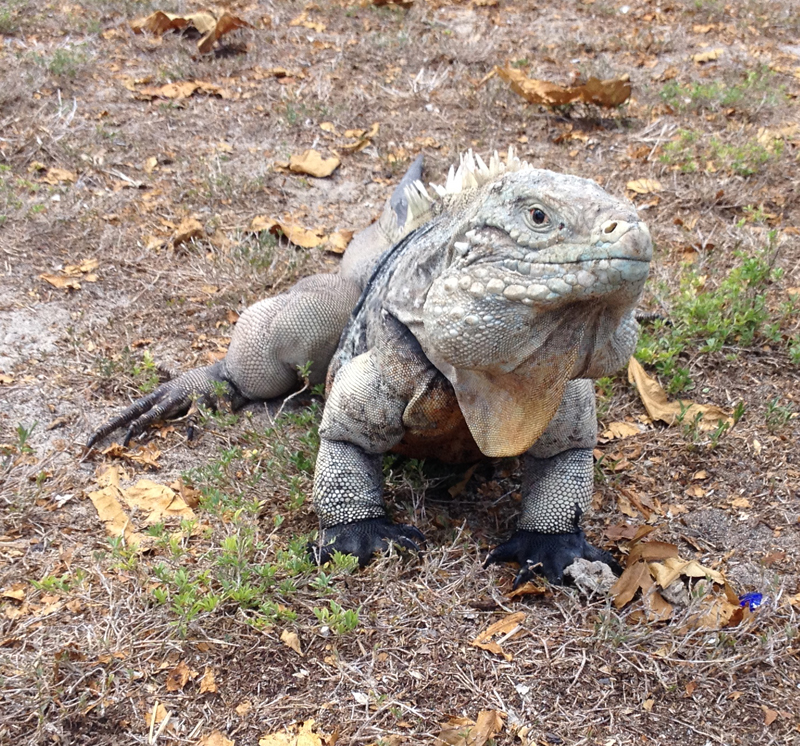
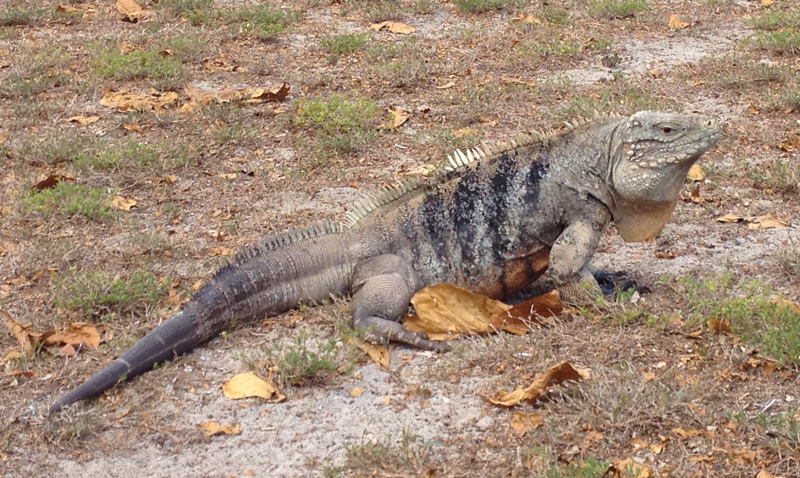

I rode my bike around the island, about 20 miles but it felt longer, traffic count 2 cars 4 iguanas. Stopping of at Sandy point the SE tip was a beautiful white sandy beach with azure sea protected by a fringing reef. Had the place to myself had a lovely swim.

Sandy Point Little Cayman

Sunset Owen’s Sound
It blew hard in the early morning with torrential rain, had a bit of a fright when I thought the mooring might be dragging so found myself stark naked in the rain and dark putting out the anchor, washed the salt off I suppose. Turned out it was just the long scope on the moooring.
Leaving through the reef was worrying with a swell running in from the south after the blow, just line up the range markers astern, aim for the middle of the small gap between marker post and buoy and then for that gap in the breakers outside, safely out phew!
Back on Cayman Brac I cycled and walked up the coast to the Brac, a big limestone cliff, home of many caves and walked up the lighthouse steps to Peter’s cave, used as a hurricane shelter by the locals.

Peter’s Cave
The other way I hiked part of the trail through the parrot reserve, didn’t see any parrots though.
I could have stayed longer on these delightful peaceful islands but if I wanted to visit Jamaica before heading out of the hurricane zone. It was time to move on.
by chris ayres | May 2016 | UK to New Zealand
Getting my clearance to leave and talking with the immigration officer on Cayman Brac. He mentioned the Cubans that had arrived a few days ago, they have no visas so will get deported back to Cuba. Apparently 2 or 3 boats arrive in the Caymans a month, crossing over a 100 miles of open sea in what a basically just lash ups, Some he said were so bad you could see the water bubbling in through the planks. He pointed out the latest, drawn up on the rocks near the dock and said that was one of the better ones. So there are still Cubans desperate enough to leave Cuba to risk all in barely seaworthy boats.
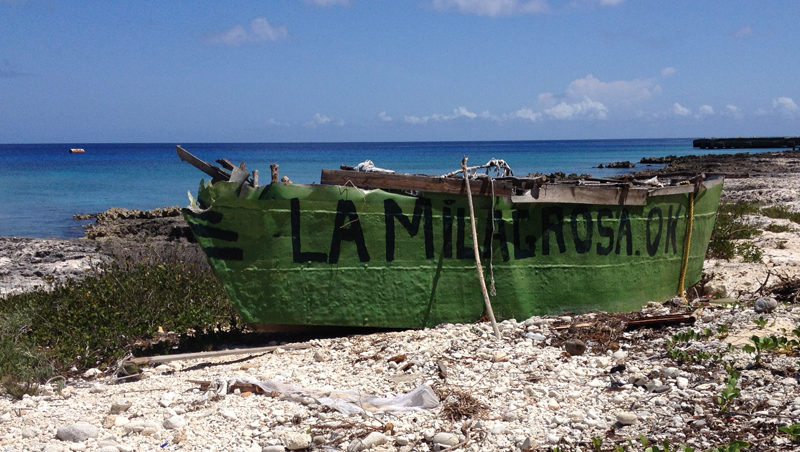

by chris ayres | May 2016 | UK to New Zealand
Talking with some locals in a bar the eve before I left Cayman Brac they told me they had heard that bad weather, a NW’erly was due tomorrow night. They were a bit incredulous saying that they just don’t get that sort of weather this time of year. I decided to clear out anyway since there are no protected anchorages here and I should be well away from the island by the time it arrived. First light next morning I got my clearance from immigration as arranged and left. I got a good start but by late morning the skies were looking increasing ominous and I confess I was a little worried. We soon had torrential rain and thunder. Still I had plenty of searoom, about a 100 miles away lay Jamaica so could afford to heave to and ride anything out if necessary. Later in the afternoon we were hit by a big squall, I had furled the yankee and had 2 reefs in the main but boy did it blow 35 – 40 knots and such torrential rain as I have never seen. It was awesome, still Sea Bear ploughed on on course whilst I sheltered on the companionway steps, raingear on just in case. It did pass and the wind drop but the skies were still dark and full of rain so I held on to not much sail, reluctant to increase it in the circumstances. A migrating swallow joined me seeking shelter from the storm and settled down to roost in the lee of the rolled up dinghy on the foredeck. Later after dark the wind shifted through 180 degrees as the front passed, the skies started to clear a little and the odd star appeared, the worst seemed to be over. Just after dawn the swallow left but returned later for a while .
A tanker bound for Houston passed, rare to see another boat in these waters. So the day gradually passed and I was joined by another little bird on passage who rested awhile perched on the pushpit. Another night and now I could see the loom of the lights of Jamaica still about 47 miles away. By dawn the coast was revealed and late morning saw me anchored opposite Montego Bay Yacht club.
I spent a few days here, visiting the “Hip Strip” a tourist haunt and the town . Its a town of two parts, inclusive hotels, tourist shops and gated residential developments and the town, all noise, smells, bustle, crowds, street stalls. Only about 50 miles down the coast was Ocho Rios but against the wind and current it took more than 24 hours and lots of tacking to get there. Another place that is very tourist orientated with big hotels and private beaches but the local part of town was interesting but I didn’t stay long clearing out the morning a big cruise ship arrived in the bay.
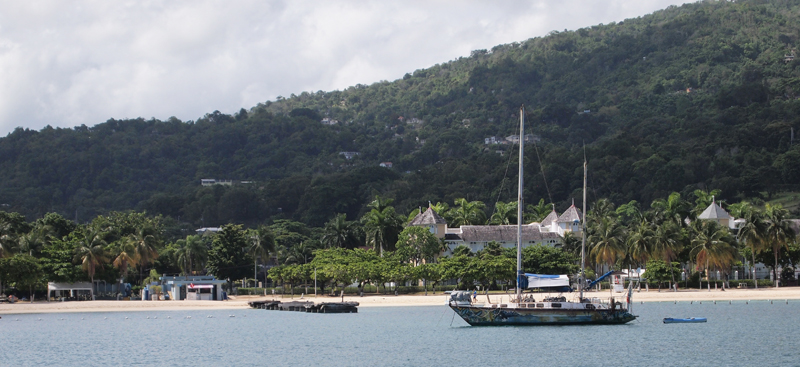
Ocho Rios
Another hard journey against wind and current eastwards to Port Antonio. At one point after tacking way from the coast and then back in I found myself closer to where I had left from than my destination. All night tacking back and forth and I seemed to be going backwards. I resolved this by motoring, much as I dislike to. Soon I was passing the Blue Mountains, very beautiful and well named and eventually turned in to the twin bays of Port Antonio and picked up a mooring off the Errol Flynn Marina.
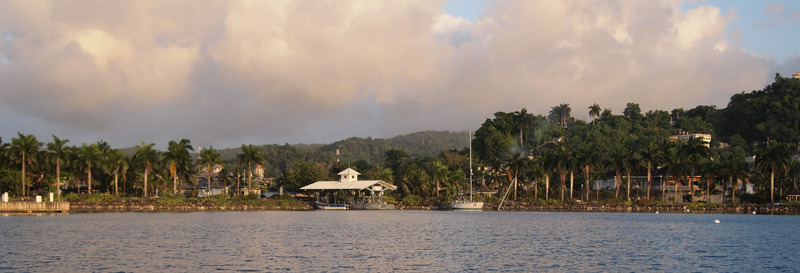
Port Antonio
This place was much more to my liking, virtually no tourists, no big hotels, no cruise ships. A very beautiful place nestled up to the foot of the blue Mountains, a well sheltered bay and a nice little town, just local Jamaican life, lots to see and do.
One day I took a bus to Kingston, the road going through the mountains, steep wooded hillsides, gorge like valleys. Got of in downtown Kingston by mistake it was even a bit much for this intrepid traveler. I have never seen a fight before by “bus loaders ” over poaching customers – real gangster stuff. Went to the Bob Marley museum in his old house, a little bit of a pilgrimage really.
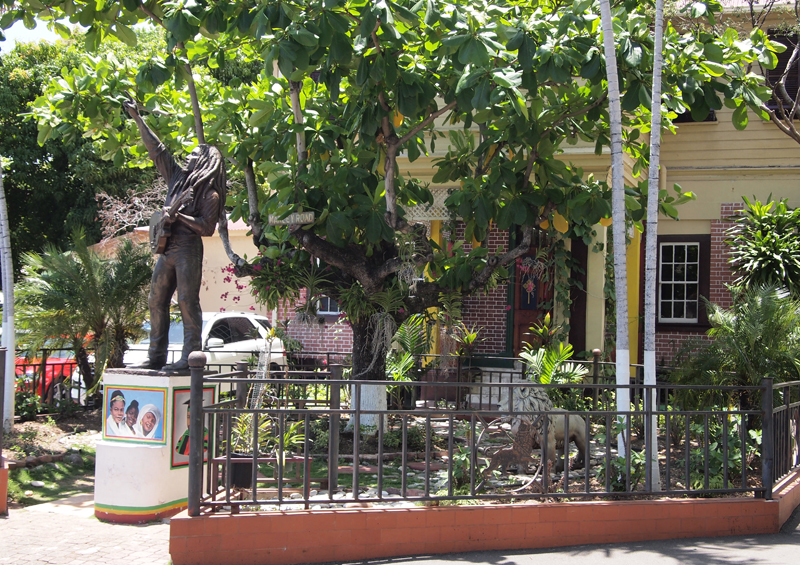
Bob Marley Museum
Another day a bus along the coast to Boston Bay, repudtly the place for the best jerk pork in Jamaica. A lovely cove of a bay, sandy beach so had a lovely swim followed by jerk pork and a beer and some rum and later another swim a great day.
I Port Antonio I became quite friendly with the owner of a little beer and rum shack on the corner entrance to what the local call “back central”, the entrance to the market. Opposite was like smokers corner with a wonderful array of characters and the sweet smell of ganga in the air all quite open. Had some good conversations over the time I was there with the owner about Jamaica and its “problems” and he looked after me, warning me of the dodgy characters and sending away the worst of the hustlers, yes there are plenty of hustlers in Jamaica. One eve they set up a sound system nearby which was great until the police turned up in flak jacket and automatic rifles – they didn’t have a permit apparently.
Labour day is a big holiday and they had a big named sound system set up at Bikini Beach, just near where the boat was moored. I went along in the eve, quite an experience, sound blaring out and the girls “shaking their booty” and rum flowing.
It is however rainy month in Jamaica so we are having our fair share of rain, generally soon over but just had a day and night of rain with plenty of thunder and lightening in the night. It is perhaps a reminder that the season is getting on. I will have to leave Jamaica shortly and head south out of the hurricane zone before the start of the hurricane season.
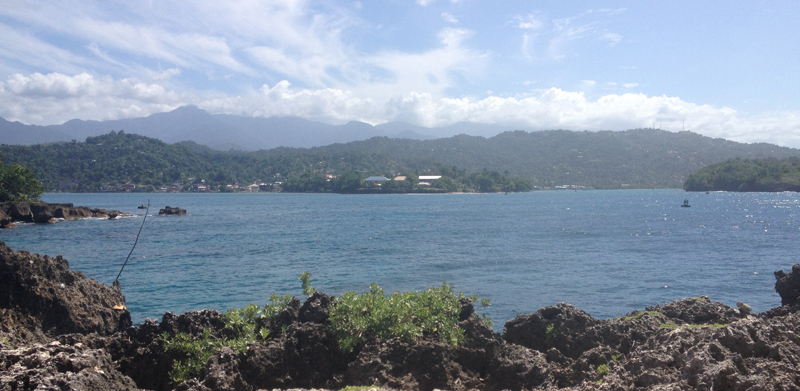
Port Antonio from Folly point
by chris ayres | Jun 2016 | UK to New Zealand
And no before I start it wasn’t a navigation error.
I had decided after much consideration of the alternatives to go to Curacao to lay up the boat for the hurricane season, I had even booked some storage there. Curacao is about 600 miles SE of Jamaica so I knew it would be a hard passage to windward but thought it do-able, but just how hard I was later to discover. I delayed my departure by a day to let some strong winds pass by but then the forecast looked OK. What they don’t tell you however is that these passage forecasts of grib files ignore what they term as local disturbances and there was one just to the SE of Jamaica right then. I’d filled up with diesel and topped up with water the day before and now the weather looked fine to set off and so it was until later when I ran into this disturbance. Dark rain squall clouds 30 knots plus of wind 12ft swells and torrential rain capped with thunder and lightning. It was not pleasant. The wind eased but throughout the first night the skies looked very threatening and lightning flashed all around. Mid morning next day conditions were better but the seas were big so it was hard work punching into them and the motion of the boat far from relaxing, lots of crashing and lurching.
Had a couple of reasonable days but noon to noon runs were disappointing in terms of distance covered then it was more squalls and a wild night.
Just to show its not all blue skies, fluffy white clouds and gentle trade winds a couple of short clips.
By the 6th day I was concerned over our slow progress, the weather which was continuing unsettled and the sea state which was rough.
4.00 am on the 8th day was the final turning point, Curacao lay 250 miles away to the SE on a course of 118 degrees, our course was 130 but our COG was 187 so a little west of south due to leeway the waves and the strong W setting equatorial current and SOG a dismal 0.7 knots. It was pretty obvious even to a stubborn skipper that we weren’t going to make Curacao.
An American who had meet in Jamaica had been selling me on the virtues of Panama, he has been keeping his boat there for past 8 years. So I decided to head there. It was about 420 miles away but importantly downwind. As soon as I altered course the differance was appreciable, gone the crashing and jerking, the motion although still lively was much more comfortable and boat speed shot up.
The weather though had not done with us yet, after a reasonable day in which we ran 90 miles noon to noon, the night grew steadily wilder and by dawn I was putting the 3rd reef in the main then handed it a bit later when the wind passed 30 knots and the seas were huge, all a bit scary. Little else to do but put the washboards in the companionway and close the hatch and lie down on a bunk.
By noon it was easing and we could raise more sail, the trouble was the wind continued to drop first to 10 – 13 knots then next day down to 6 knots and then calm. Now us sailors we are never happy there is always either a deal too much wind or not enough. 11 days out and we had to resort to motoring. That was OK for some hours until the engine started to falter and then die. Sounded like fuel starvation to me and problem fairly soon traced to a blocked air vent pipe to the fuel tank. For good measure I cleaned out the fuel filter and separator just in case there was water in the fuel, bleed the system and we were running again, although hadn’t managed to clear the blockage in the vent pipe I could get around this by loosening the fuel filler cap from time to time to let some air into the tank.
Late afternoon of our 12th day out we sited land off to our port side. Had a bit of a scare that night wen a sailboat appeared close by, no AIS, no lights showing, all sails up and fluttering but obviously moving under engine. A powerful light flashed over it brought no response at all and I had to take evading action. The morning of our 13th day on passage we closed the rocks and light on Farallon Sucio and shortly after passed between Isla Verde and the rocks of Bajosalmedio to enter the bay of Portabelo, Panama. It was so good to see green hillsides again. We finally anchored off one of the old forts and the little town of Portabelo. A passage of 835 miles
by chris ayres | Jun 2016 | UK to New Zealand

Sea Bear at anchor under the guns of the fort
Portobelo is half a day’s sail away from Colón, at the northern entrance of the Panama canal.
It is a small historical city, part of the Spanish Main (Cartagena/Portobello/San Lorenzo) and quite interesting. Portobelo was discovered by Christopher Columbus in 1502 and the city was established in 1586 as a Caribbean transhipment center for the South American riches the Spaniards took back to Spain. The treasure house is still there and it is said that once they took out all the silver and stacked it in the streets to make room for all the gold.
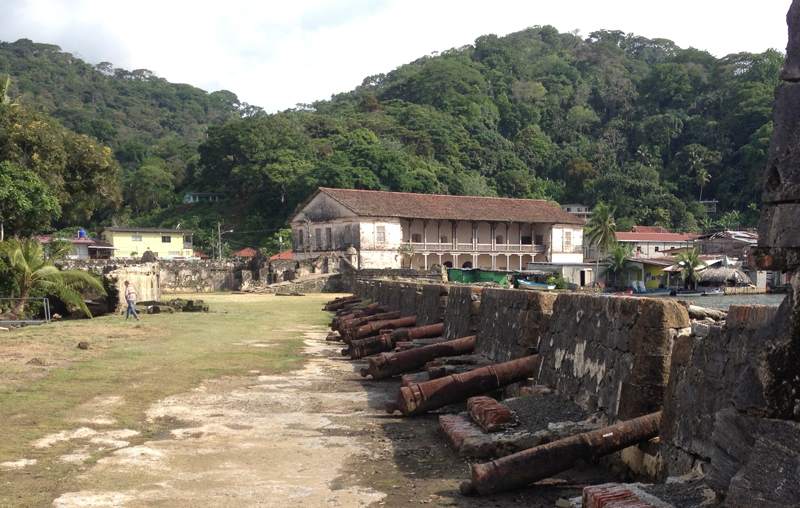
The treasure house and fort
Also dating from the Spanish is a cathedral which is renowned for its black Christ statue
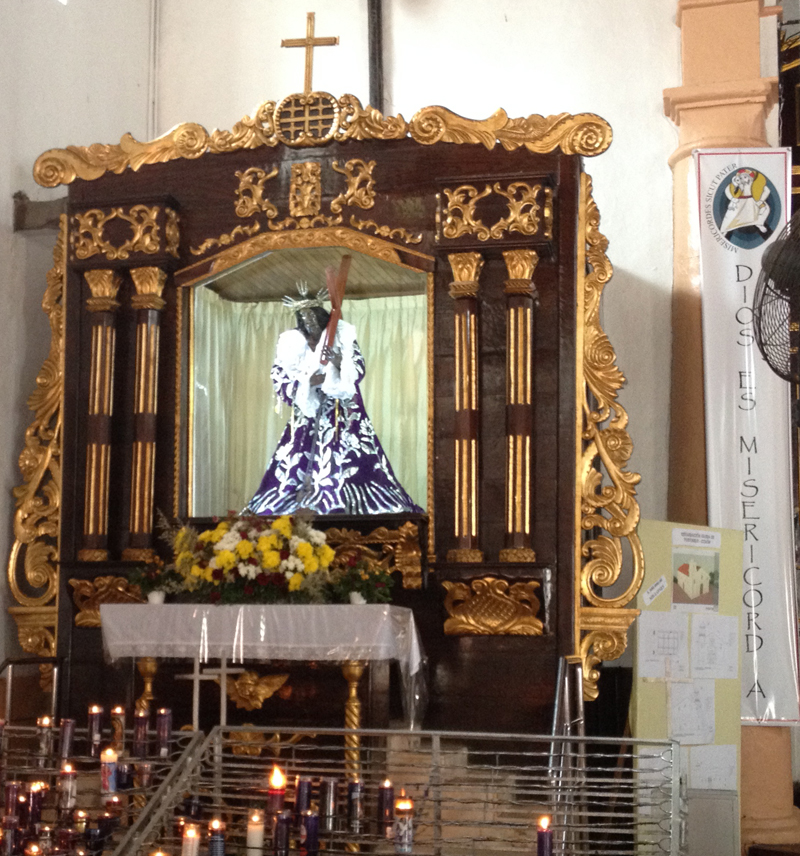
The black Christ
The jungle has reclaimed some of the fortifications but some have been cleared and the canons are still there, still laying where they were abandoned all those years ago.
It is also the burial place of Sir Frances Drake, the 16th century English explorer who was buried at sea off Drake’s island.
The bay is beautiful, surrounded by wooded hills with humming birds and parrots.

A beer in a bar by the bay
I enjoyed my stay here and although had thought of it as a destination realising that there was more to Panama than just the canal and that the area would bear closer exploration.
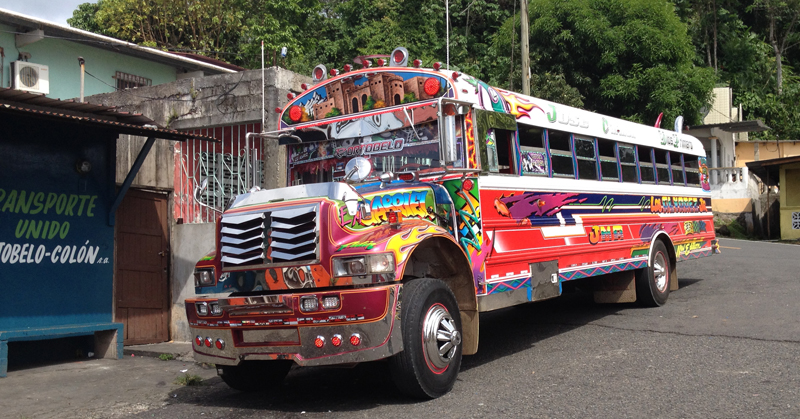
A local bus
by chris ayres | Aug 2016 | UK to New Zealand
Despite Portabelo being a port of entry I was having trouble with the formalities. Even after two visits to immigration I still had not been given an entry stamp. They did not like it that my clearance from Jamaica had Curacao as destination as although I had explained and written them a statement with the explanation they would not stamp my passport, saying that I had to visit immigration in Colon. So much as I was enjoying Portabelo I decide to go to Shelter Bay near Colon and since it was the rainy season anyway, thought I might haul out, lay the boat up and go back to UK for a bit. So early one morning, having put all arrangements in place I weighed anchor and set off down the coast towards Colon. Shelter Bay is situated inside the Colon breakwater, which protects the entrance to the Panama Canal so closing it it was busy with many ships, some at anchor and some on the move and permission has to be sought over VHF from the harbour authorities to enter. Permission granted I passed inside the breakwater and motored to the marina, They were ready for me so, straight into the haul out dock. Paper work completed and soon Sea Bear was ashore and shored up in the yard.
The marina is on the site of what was the American jungle warfare training centre Fort Sherman so is surrounded by jungle which is slowly reclaiming most of the old military buildings.

The marina had a free bus service which ran into Colon so Monday morning first thing I was on the bus, it was a longer journey than I thought and crossed the canal at one of the Gatun locks. As well as sorting out my entry stamp with immigration I had to get my cruising permit sorted. I’ll not bore you with the details suffice it to say it took me from 09.300 until 14.00, visits to 2 different offices, numerous forms to fill in, photocopies to submit and 2 taxi rides across town. Bureaucracy is alive and well in Panama and there is still a market for tippex. Colon has a bad reputation for muggings and it is not advised for ‘gringos’ to walk in the town, hence the taxi. One good thing though, the women in the shipping office advised me that the fare should be no more than 2$ , outside agreeing with the taxi driver the fare he said well for tourists its 2$ but for locals 1$ I’ll charge you 1$. The drive was interesting, chaotic traffic but I have never seen such a run down City in all my travels, it was a bit shocking really.
A few days later with Sea Bear safely laid up a taxi took me for the one and half hour ride over the isthmus to the airport at Panama City. A flight via Mexico City took me to Heathrow so I’m back in UK for a bit. Be nice to see family and friends again. I’ll return to Panama after the rainy season and am looking forward to exploring it.


















